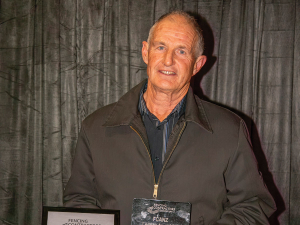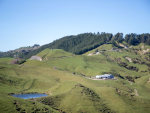Blackwell runs breeding ewes and Friesian bulls on a 345ha property in Okahu, southeast of Dargaville.
While maintaining liveweight gain gets difficult in the region’s long dry summers he thinks a permanent chicory pasture might be the answer.
Blackwell told farmers at a Northland Beef and Lamb ‘Finished By 20 Months’ field day that he has added 25-45kg to liveweight gains in normal summers and by 76kg in a drought by putting bulls onto chicory.
In the chicory trial Blackwell cultivated and planted chicory on 8ha of an intensive beef grazing block, setting aside another 15ha of the block to be grazed by control groups.
He then split 120 autumn-born 100kg Friesian bulls into six mobs, running two on pasture, two on chicory and two on a herbage mix.
Researchers simplified the trial in its second year, 2012-13, dropping the herbage mix and running fewer but spring-born bulls instead.
The chicory was profitable in both years of the trial but Blackwell says it was in the dry of last summer that it really provided results, growing 80kgDM/ha/day in December, when pasture was producing little over 20kgDM/ha/day.
This gap continued through summer and in May the chicory grew 63kgDM/ha/day compared to a little under 30kgDM/ha from pasture.
AgFirst consultant and project leader Chris Boom notes the kgDM content of the chicory remained three times higher than that of pasture.
Bulls on the chicory gained 0.8kg/day December-May in 2012-13, ending up 76kg heavier than those on pasture, which gained 0.34kg/day, says Blackwell.
“The chicory grew a little less [than the previous season] but the pasture grew a lot less.”
In fact, there was so little pasture available that he had to feed silage to the control group to prevent animal health problems. “I was starting to see the odd case of grass staggers and I thought I might start loosing them to misadventure.”
Chicory’s edge is because ryegrass roots only go down a few inches, whereas chicory’s taproots go down close to two metres, making it more able to weather the drought, says Blackwell.
But by April even the chicory was not growing as fast so he slowed down the grazing round to half a paddock every day.
Then when rain came, the chicory shot away. “I had to speed up the round again.”
Boom calculates the cost of the extra liveweight gain on chicory was $1.75/extra kg lwt in 2011-12, when an extra 395kg lwt/ha was produced, and $1.45/kg in 2012-13 when advantage over grass was 530kg lwt/ha.
He says this would be marginal if farmers were planning on selling stock at the end of autumn when schedules are at their lowest.
Blackwell says this happened in the first year of the trial when some animals involved in the herbage trial failed to make weight in time and needed to be carried until May to reach targets.
“The stock on the pasture caught up and the gap was reduced to 25kg instead of 45kg…. It would have been better if I could have got everything off the farm by February.”
While Blackwell sprayed out the 2011-12 chicory crop he has left the 2012-13 one in and project leaders plan to look at how it performs for a second year.
Boom says the crop has already paid for itself so it will be interesting to see how it goes from here on in.

















